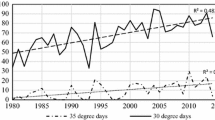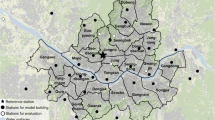Abstract
Brazilian cities host 86% of the country’s population and have been more intensely hit by rising temperatures than the average of cities across the world over the last century. Nevertheless, assessments of the vulnerability of Brazilian urban dwellers to urban heat islands (UHI) are scarce. In this study, we take advantage of the availability of high-resolution data to calculate the heat stress vulnerability and risk indexes (HSVI and HSRI, respectively) for people inhabiting six Brazilian metropolitan areas—Manaus, Natal, Vitória, São Paulo, Curitiba, and Porto Alegre. The indexes are calculated by mathematically relating indicators of exposure (distribution of >65-year-old elderly people), sensitivity/adaptive capacity (human development index, HDI), and hazard (surface temperature). The resulting HSVI maps reflect the socioeconomic (HDI) differences found among the studied cities, with the most vulnerable people located in the poorest neighborhoods in Manaus (0.720) and Natal (0.733), distributed among lower- and mid-class zones in São Paulo (0.794) and Vitória (0.772), or invariably located in the wealthy zones of Curitiba (0.783) and Porto Alegre (0.762). Two distinct patterns are identified for the HSRI: in São Paulo, Vitória, Curitiba, and Porto Alegre, high and very high risks are found in the wealthy zones of the cities, whereas in Natal and Manaus, high and very high risks are encountered in the poorly developed city zones, a result that was strongly driven by the UHI pattern. Better communication of heat stress risk and the improvement of city greenness should be the focus of near-term adaptation strategies for the mapped vulnerable population.




Similar content being viewed by others
References
Aldrich N, Benson W (2008) Disaster preparedness and the chronic disease needs of vulnerable older adults. Prev Chronic 5:1–7
Amato-Lourenço LF, Moreira TCL, Arantes BL de, Silva Filho DF da, Mauad T (2016) Metrópoles, cobertura vegetal, áreas verdes e saúde . Estudos Avançados 30(86):113-130. https://doi.org/10.1590/S0103-40142016.00100008
Arretche M (2015) Trajetórias das desigualdades: como o Brasil mudou nos últimos cinquenta anos. Editora Unesp., São Paulo
Aubrecht C, Özceylan D (2013) Identification of heat risk patterns in the U.S. national capital region by integrating heat stress and related vulnerability. Environ Int 56:65–77. https://doi.org/10.1016/j.envint.2013.03.005
Azevedo PV, Bezerra PTC, Leitão MMVBR, Santos CAC (2017) Thermal comfort level assessment in urban area of Petrolina - PE county, Brazil. Revista Brasileira de Meteorologia 32(4):555–563
Camilo M, Counsell CWW, Bielecki CR, Louis LV (2017) Twenty-seven ways a heat wave can kill you. Circ Cardiovasc Qual Outcomes 10(11):e004233. https://doi.org/10.1161/CIRCOUTCOMES.117.004233
Cardona OD, van Aalst MK, Birkmann J, Fordham M, McGregor G, Perez R et al (2012) Determinants of risk: exposure and vulnerability. In: Field CB, Barros V, Stocker TF, Qin D, Dokken DJ, Ebi K-L et al (eds) Managing the risks of extreme events and disasters to advance climate change adaptation — a special report of Working Groups I and II of the Intergovernmental Panel on Climate Change (IPCC). Cambridge University Press, Cambridge, pp 65–108
Coffel ED, de Sherbinin A, Horton RM, Lane K, Kienberger S, Wilhelmi O (2018) Chapter 7 — The science of adaptation to extreme heat. In: Zommers Z, Alverson KBT-R (eds) pp. 89–103. Elsevier, Amsterdam https://doi.org/10.1016/B978-0-12-811891-7.00007-4
Darela-Filho JP, Lapola DM, Torres RR, Lemos MC (2016) Socio-climatic hotspots in Brazil: how do changes driven by the new set of IPCC climatic projections affect their relevance for policy? Clim Chang 136:413–425. https://doi.org/10.1007/s10584-016-1635-z
de Sherbinin A, Bardy G (2016) Social vulnerability to floods in two coastal megacities: New York City and Mumbai. Vienna Yearb Popul Res 13:131–165. https://doi.org/10.1553/populationyearbook2015s131
Di Giulio GM, Vasconcellos M da P (2014) Contribuições das Ciências Humanas para o debate sobre mudanças ambientais: um olhar sobre São Paulo . Estudos Avançados 28(82):41-63. https://doi.org/10.1590/S0103-40142014000300004
Di Giulio GM, Bedran-Martins AM, Vasconcellos M d P, Ribeiro WC (2017) Mudanças climáticas, riscos e adaptação na megacidade de São Paulo, Brasil. Sustentabilidade Em Debate 8(2). https://doi.org/10.18472/SustDeb.v8n2.2017.19868
Di Giulio GM, Bedran-Martins AMB, Vasconcellos M d P, Ribeiro WC, Lemos MC (2018) Mainstreaming climate adaptation in the megacity of São Paulo, Brazil. Cities 72:237–244. https://doi.org/10.1016/j.cities.2017.09.001
Eakin H, Bojórquez-Tapia L (2008) Insights into the composition of household vulnerability from multicriteria decision analysis. Glob Environ Chang 18(1):112–127
Eakin HC, Lemos MC, Nelson DR (2014) Differentiating capacities as a means to sustainable climate change adaptation. Glob Environ Chang 27:1–8. https://doi.org/10.1016/j.gloenvcha.2014.04.013
Geirinhas JL, Trigo RM, Libonati R, Cristina A (2017) Climatic and synoptic characterization of heat waves in Brazil. Int J Climatol 38(4):1760–1776. https://doi.org/10.1002/joc.5294
Green TL, Kronenberg J, Andersson E, Elmqvist T, Gómez-Baggethun E (2016) Insurance value of green infrastructure in and around cities. Ecosystems 19(6):1051–1063. https://doi.org/10.1007/s10021-016-9986-x
Guo Y, Gasparrini A, Li S, Sera F, Vicedo-Cabrera AM et al (2018) Quantifying excess deaths related to heatwaves under climate change scenarios: a multicountry time series modelling study. PLoS Med 15(7):e10022629. https://doi.org/10.1371/journal.pmed.1002629
Harlan S, Brazel A, Prashad L, Stefanov W, Larsen L (2006) Neighborhood microclimates and vulnerability to heat stress. Soc Sci Med 63:2847–2863
Hurlimann AC, March AP (2012) The role of spatial planning in adapting to climate change. WIREs Climate Change 3(October):477–488. https://doi.org/10.1002/wcc.183
IBGE (2010) Censo demográfico 2010: aglomerados subnormais - primeiros resultados. Rio de Janeiro.
IBGE (2017) Monitoramento da cobertura e uso da terra no Brasil 2000–2010 - 2012 - 2014. Rio de Janeiro.
Imhoff ML, Zhang P, Wolfe RE, Bounoua L (2010) Remote sensing of the urban heat island effect across biomes in the continental USA. Remote Sens Environ 114(3):504–513. https://doi.org/10.1016/j.rse.2009.10.008
Jackson TL, Feddema JJ, Oleson KW, Bonan GB, Bauer JT (2010) Parameterization of urban characteristics for global climate modeling. Ann Assoc Am Geogr 100(4):848–865. https://doi.org/10.1080/00045608.2010.497328
Jimenez-Munoz J-C, Sobrino J, Skokovic D, Mattar C, Cristóbal Rosselló J (2014) Land surface temperature retrieval methods from Landsat-8 thermal infrared sensor data. IEEE Geosci Remote S 11(10):1840–1843. https://doi.org/10.1109/LGRS.2014.2312032
Kabisch N, Korn H, Stadler J, Bonn A (Eds.) (2017) Nature-based solutions to climate change adaptation in urban areas. Springer, Cham
Kawashima S, Ishida T, Minomura M, Miwa T (2000) Relations between surface temperature and air temperature on a local scale during winter nights. J Appl Meteorol 39(9):1570–1579. https://doi.org/10.1175/1520-0450(2000)039<1570:RBSTAA>2.0.CO;2
Klinenberg E (2003) Review of heat wave: a social autopsy of disaster in Chicago. N Engl J Med 348(7):666–667
Krayenhoff ES, Moustaoui M, Broadbent AM, Gupta V, Georgescu M (2018) Diurnal interaction between urban expansion, climate change and adaptation in US cities. Nat Clim Chang 8:1097-1103. https://doi.org/10.1038/s41558-018-0320-9
Lane K (2014) Extreme heat awareness and protective behaviors in New York City. J Urban Heal 91:403–414
Lemos MC, Kirchhoff C (2018) Climate information and water management: building adaptive capacity or business as usual? In: Conca K, Weinthal E (eds) The Oxford handbook of water politics and policy. Oxford University Press, New York, pp 616–636
Lemos MC, Kirchhoff CJ, Ramprasad V (2012) Narrowing the climate information usability gap. Nat Clim Chang 2:789-794. https://doi.org/10.1038/nclimate1614
Li D, Bou-Zeid E, Oppenheimer M (2014) The effectiveness of cool and green roofs as urban heat island mitigation strategies. Environ Res Lett 9:55002
Li D, Malyshev S, Shevliakova E (2016) Exploring historical and future urban climate in the Earth system modeling framework: 2. Impact of urban land use over the continental United States. J Adv Model Earth Syst 8(2):936–953. https://doi.org/10.1002/2015MS000579
Marques E, Saraiva C (2017) Urban integration or reconfigured inequalities? Analyzing housing precarity in São Paulo, Brazil. Habitat Int 69:18–26. https://doi.org/10.1016/j.habitatint.2017.08.004
Martins RD, Ferreira L d C (2011) Climate change action at the city level: tales from two megacities in Brazil. Manag Environ Qual Int J 22(3):344–357. https://doi.org/10.1108/14777831111122914
McMichael AJ (2003) Global climate change and health: an old story writ large. In: McMichael A et al (eds) Climate change and human health: risks and responses. World Health Organization, Geneva
Moser SC, Boykoff MT (2013) Successful Adaptation to Climate Change: Linking Science and Practice in a Rapidly Changing World. Routledge, London
Nobre CA, Young AF (2011) Vulnerabilidades das megacidades brasileiras às mudanças climáticas: região metropolitana de São Paulo. São José dos Campos, Campinas.
Norton BA, Coutts AM, Livesley SJ, Harris RJ, Hunter AM, Williams NSG (2015) Planning for cooler cities: a framework to prioritise green infrastructure to mitigate high temperatures in urban landscapes. Landsc Urban Plan 134:127–138. https://doi.org/10.1016/j.landurbplan.2014.10.018
Oleson K (2012) Contrasts between urban and rural climate in CCSM4 CMIP5 climate change scenarios. J Clim 25(5):1390–1412. https://doi.org/10.1175/JCLI-D-11-00098.1
Preston BL, Yuen EJ, Westaway RM (2011) Putting vulnerability to climate change on the map: a review of approaches, benefits, and risks. Sustain Sci 6(2):177–202. https://doi.org/10.1007/s11625-011-0129-1
Reid CE, O’Neill MS, Gronlund CJ, Brines SJ, Brown DG, Diez-Roux AV, Schwartz J (2009) Mapping community determinants of heat vulnerability. Environ Health Perspect 117(11):1730–1736. https://doi.org/10.1289/ehp.0900683
Revi A, Satterthwaite DE, Aragón-Durand F, Corfee-Morlot J, Kiunsi RBR, Pelling M et al (2014) Urban areas. In: Field CB, Barros V, Dokken DJ et al (eds) Climate change 2014: impacts, adaptation, and vulnerability. Part A: global and sectoral aspects. Contribution of Working Group II to the Fifth Assessment Report of the Intergovernmental Panel of Climate Change. Cambridge University Press, Cambridge, UK, pp 535–612
Robine JM, Cheung SLK, Roy SL, Van Oyen H, Griffiths C, Michel JP, Hermann FR (2008) Death toll exceeded 70,000 in Europe during the summer of 2003. C R Biol 331:171–178
Robine JM, Michel JP, Hermann FR (2012) Excess male mortality and age-specific mortality trajectories under different mortality conditions: A lesson from the heat wave of summer 2003. Mech Ageing Dev 133(6):378–386
Serrao-Neumann S, Renouf M, Kenway SJ, Low Choy D (2017) Connecting land-use and water planning: prospects for an urban water metabolism approach. Cities 60:13–27. https://doi.org/10.1016/j.cities.2016.07.003
Setzer J, Macedo LV, Rei F (2017) Combining local and transnational action in the adoption and implementation of climate policies in the city of São Paulo. In: Johnson C, Toly N, Schroeder H (Eds.) The urban climate challenge: rethinking the role of cities in the global climate regime Routledge, London, pp 101–118
The World Bank (2017) World Bank Open Data. Retrieved December 28, 2017, from https://data.worldbank.org/indicator/SP.URB.TOTL.IN.ZS
Torres RR, Lapola DM, Marengo JA, Lombardo MA (2012) Socio-climatic hotspots in Brazil. Clim Chang 115:597–609. https://doi.org/10.1007/s10584-012-0461-1
UNDP Brazil (2018) Radar IDHM. Retrieved May 9, 2018, from http://atlasbrasil.org.br/2013/pt/radar-idhm/
Vadász V (1994) On the relationship between surface temperature, air temperature and vegetation index. Adv Space Res 14(3):41–44. https://doi.org/10.1016/0273-1177(94)90190-2
Watts N, Amann M, Arnell N, Ayeb-karlsson S, Belesova K, Berry H et al (2018) The 2018 report of the Lancet Countdown on health and climate change: shaping the health of nations for centuries to come. Lancet 6736(18):1–36. https://doi.org/10.1016/S0140-6736(18)32594-7
Weber S, Sadoff N, Zell E, de Sherbinin A (2015) Policy-relevant indicators for mapping the vulnerability of urban populations to extreme heat events: A case study of Philadelphia. Appl Geogr 63:231–243. https://doi.org/10.1016/j.apgeog.2015.07.006
Wise RM, Fazey I, Stafford Smith M, Park SE, Eakin HC, Archer Van Garderen ERM, Campbell B (2014) Reconceptualising adaptation to climate change as part of pathways of change and response. Glob Environ Chang 28:325–336. https://doi.org/10.1016/j.gloenvcha.2013.12.002
Zhao L, Lee X, Schultz NM (2017) A wedge strategy for mitigation of urban warming in future climate scenarios. Atmos Chem Phys 17(14):9067–9080. https://doi.org/10.5194/acp-17-9067-2017
Acknowledgments
This study is part of the CiAdapta project (Cities, Vulnerability and Climate Change: an integrated and interdisciplinary approach to analyze actions and adaptive capacity) funded by Brazil’s National Council for Scientific and Technological Development – CNPq (Proc. 446032/2015-8). A full dataset table with the employed variables and resulting indexes for each of the census tracts within the six studied metropolitan regions is available as supplementary material of this article. We are grateful to all the public officials of the six studied metropolitan areas who participated in this project and to V. A. Nogueira, A. C. Penna, and A. Premebida and two anonymous reviewers for helpful comments on this manuscript.
Author information
Authors and Affiliations
Corresponding author
Additional information
Publisher’s note
Springer Nature remains neutral with regard to jurisdictional claims in published maps and institutional affiliations.
Rights and permissions
About this article
Cite this article
Lapola, D.M., Braga, D.R., Di Giulio, G.M. et al. Heat stress vulnerability and risk at the (super) local scale in six Brazilian capitals. Climatic Change 154, 477–492 (2019). https://doi.org/10.1007/s10584-019-02459-w
Received:
Accepted:
Published:
Issue Date:
DOI: https://doi.org/10.1007/s10584-019-02459-w




